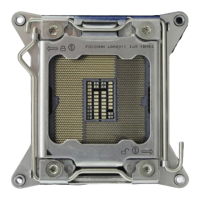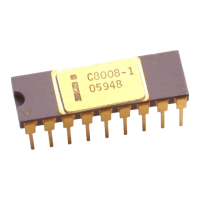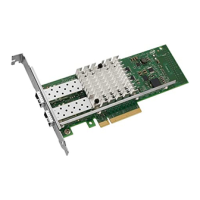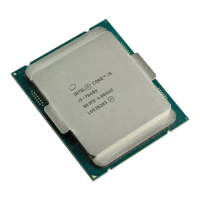Intel® Xeon™ Processor with 800 MHz System Bus
68 Datasheet
will violate the thermal specifications and may result in permanent damage to the processor. Intel
has developed these thermal profiles to allow OEMs to choose the thermal solution and
environmental parameters that best suit their platform implementation. Refer to the appropriate
thermal/mechanical design guide for details on system thermal solution design, thermal profiles,
and environmental considerations.
The upper point of the thermal profile consists of the Thermal Design Power (TDP) defined in
Table 23 and the associated T
CASE
value. It should be noted that the upper point associated with
Thermal Profile B (x = TDP and y = T
CASE_MAX_B
@ TDP) represents a thermal solution design
point. In actuality the processor case temperature will never reach this value due to TCC activation
(see Figure 23). The lower point of the thermal profile consists of x = P
CONTROL_BASE
and y =
T
CASE_MAX
@ P
CONTROL_BASE
. Pcontrol is defined as the processor power at which T
CASE
,
calculated from the thermal profile, corresponds to the lowest possible value of Tcontrol. This point
is associated with the Tcontrol value (see Section 6.2.6) However, because Tcontrol represents a
diode temperature, it is necessary to define the associated case temperature. This is T
CASE_MAX
@
P
CONTROL_BASE
. Please see Section 6.2.6 and the appropriate thermal/mechanical design guide for
proper usage of the Tcontrol specification.
The case temperature is defined at the geometric top center of the processor IHS. Analysis
indicates that real applications are unlikely to cause the processor to consume maximum power
dissipation for sustained time periods. Intel recommends that complete thermal solution designs
target the Thermal Design Power (TDP) indicated in Table 23, instead of the maximum processor
power consumption. The Thermal Monitor feature is intended to help protect the processor in the
event that an application exceeds the TDP recommendation for a sustained time period. For more
details on this feature, refer to Section 6.2. To ensure maximum flexibility for future requirements,
systems should be designed to the Flexible Motherboard (FMB) guidelines, even if a processor
with a lower thermal dissipation is currently planned. Thermal Monitor feature must be enabled
for the processor to remain within specification.
NOTES:
1. These values are specified at V
CC_MAX
for all processor frequencies. Systems must be designed to ensure
the processor is not to be subjected to any static V
CC
and I
CC
combination wherein V
CC
exceeds V
CC_MAX
at
specified I
CC
. Please refer to the V
CC
static and transient tolerance specifications in Section 2.0.
2. Listed frequencies are not necessarily committed production frequencies.
3. Maximum Power is the maximum thermal power that can be dissipated by the processor through the
integrated heat spreader (IHS). Maximum Power is measured at maximum T
CASE
.
4. Thermal Design Power (TDP) should be used for processor/chipset thermal solution design targets. TDP is
not the maximum power that the processor can dissipate. TDP is measured at maximum T
CASE
.
5. These specifications are based on silicon characterization, however they may be updated as further data
becomes available.
6. Power specifications are defined at all VIDs found in Table 9. The Intel® Xeon™ processor with 800 MHz
system bus may be shipped under multiple VIDs listed for each frequency.
7. FMB, or Flexible Motherboard, guidelines provide a design target for meeting all planned processor
frequency requirements. FMB is a design target that is sequential in time.
Table 23. Intel® Xeon™ Processor with 800 MHz System Bus Thermal Specifications
Core
Frequency
(GHz)
Maximum
Power
(W)
Thermal
Design Power
(W)
Minimum
T
CASE
(°C)
Maximum
T
CASE
(°C)
Notes
2.80 GHz - FMB 111 103 5 See Figure 13; Table 24
or Table 25
1,2,3,4,5,6,7
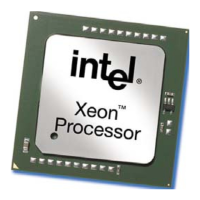
